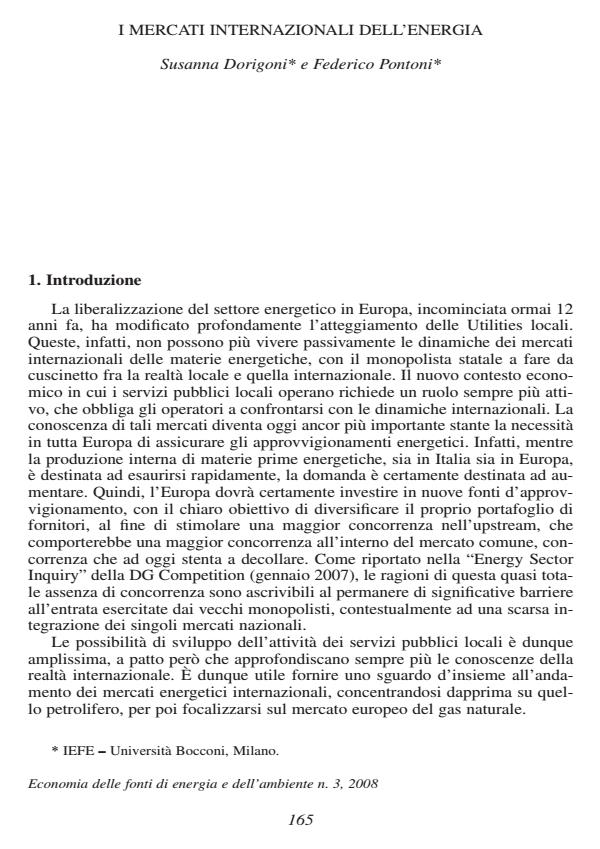I mercati internazionali dell'energia
Titolo Rivista ECONOMIA DELLE FONTI DI ENERGIA E DELL’AMBIENTE
Autori/Curatori Susanna Dorigoni, Federica Pontoni
Anno di pubblicazione 2009 Fascicolo 2008/3 Lingua Italiano
Numero pagine 9 P. 165-173 Dimensione file 559 KB
DOI 10.3280/EFE2008-003008
Il DOI è il codice a barre della proprietà intellettuale: per saperne di più
clicca qui
Qui sotto puoi vedere in anteprima la prima pagina di questo articolo.
Se questo articolo ti interessa, lo puoi acquistare (e scaricare in formato pdf) seguendo le facili indicazioni per acquistare il download credit. Acquista Download Credits per scaricare questo Articolo in formato PDF

FrancoAngeli è membro della Publishers International Linking Association, Inc (PILA)associazione indipendente e non profit per facilitare (attraverso i servizi tecnologici implementati da CrossRef.org) l’accesso degli studiosi ai contenuti digitali nelle pubblicazioni professionali e scientifiche
International Energy Marke - The paper analyzes recent market trends in the oil and natural gas sector. For the latter, a focus on the European gas market is then presented, whose consumption has grown considerably in these last ten years. As for the oil sector this paper investigates the key elements that have shaped its market in these years. As for oil consumption, we show that in these last 15 years China, India and the Middle East are the main responsible for the increase in World consumption. On the other hand, European OECD Countries have consistently reduced (almost 9%) their oil demand. This is due both to the dematerialization of their economy and their significant improvements in energy efficiency. As for energy intensity, in fact, Europe by far is the most efficient region in the World. On the other hand, OPEC has drastically raised its share of total production: at present the cartel accounts for more than 40% of overall production. OPEC members were the only producers to meet World’s needs as oil demand expanded. The difficulties of other producers to keep up with the demand originated in the nineties, when no investment in new production capacity was brought about due to low oil prices. In the end of 2008, anyway, recession has eased the situation: for the first time in fifteen years, demand has not grown, compared to 2007 consumption. Recession has also shrunk prices, which, as soon as the demand started decreasing, have collapsed by almost 70%. As for the gas sector, the paper focuses on the European market where, after ten years from the beginning of the liberalization process, competition is still missing. In particular, the paper discusses whether LNG can bring about the competition so desperately needed. Unlike investments in pipelines, those in the LNG chain present a much lower degree of specificity, since the importer is not physically tied with the producer; moreover, it is getting increasingly common that part of the plant capacity is made available for spot transactions. It is also worth mentioning that for the time being LNG seems to represent the sole possibility for new competitors to enter the market according to the lack of capacity on international import pipelines. Long term import take or pay contracts held by gas incumbents play a pre-emption activity on transit pipelines and access can not be granted to third parties. Moreover, LNG could enable traditional European importers to widen their gas suppliers’ portfolio, also considering that some producing countries (i.e. stranded gas) can be reached only via sea. Increased possibilities of choice for importers, the widening of the group of exporting countries, and the increased integration of the European market, thanks to the possibility of redirecting cargoes depending on single countries’ supply-demand balance, would contribute decisively to security of supply, market globalization and competition in the industry. The paper presents also a cost plus comparison among different LNG supplies and those from new Russian fields, demonstrating that LNG will be even more convenient than those supplies coming from Eastern Siberia. Finally, it is important to highlight that the lack in new liquefaction capacity could undermine the growth of a florid LNG market.
Key words: Oil and gas sector, liberalization, LNG.
JEL classifications: Q40, Q41, Q43, Q48.
Parole chiave: Mercato del petrolio e del gas, liberalizzazione e GNL.;
Susanna Dorigoni, Federica Pontoni, I mercati internazionali dell'energia in "ECONOMIA DELLE FONTI DI ENERGIA E DELL’AMBIENTE" 3/2008, pp 165-173, DOI: 10.3280/EFE2008-003008